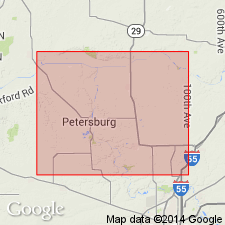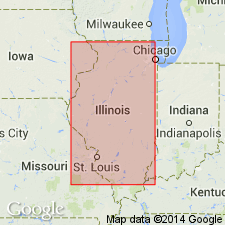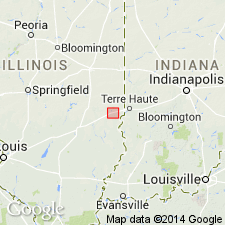
- Usage in publication:
-
- Petersburg silt
- Modifications:
-
- First used
- Dominant lithology:
-
- Silt
- AAPG geologic province:
-
- Illinois basin
Summary:
Name Petersburg silt introduced for thick fossiliferous unit below Payson Till. This silt has been referred to previously as Loveland, but as it lies below oldest Illinoian till, it seemingly is not stratigraphic or age equivalent of Loveland or Great Plains. It either represents a glacial pulsation earlier than the Payson or was derived from advancing Payson glacier. Age is Pleistocene (Illinoian).
Source: GNU records (USGS DDS-6; Reston GNULEX).

- Usage in publication:
-
- Petersburg Silt
- Modifications:
-
- Named
- Dominant lithology:
-
- Silt
- AAPG geologic province:
-
- Illinois basin
Summary:
Name Petersburg Silt formally proposed and type section designated south of Petersburg, Menard Co., IL, where unit is 20 ft thick and consists of massive compact silt, gray-tan in upper part and purplish-brown in lower part. In most localities consists of both water-laid and wind-deposited silts. Age is Pleistocene (early Illinoian).
Source: GNU records (USGS DDS-6; Reston GNULEX).

- Usage in publication:
-
- Petersburg Silt
- Modifications:
-
- Overview
- AAPG geologic province:
-
- Illinois basin
Summary:
In the study area, the Petersburg is composed of brown, laminated or uniform, fossiliferous silt loam and less commonly, well sorted, very fine to coarse grained sand. Contains abundant coniferous wood fragments and a few gastropod shells. Occurs below an elevation of about 505 ft in the bedrock valleys, where it reaches 50.4 ft in thickness. Mean thickness at the Martinsville site is 5.7 ft, but it is less than 2 ft thick or absent to the east and south. Overlies informal Martinsville sand or Lierle Clay Member of Banner Formation. Underlies Smithboro Till Member of Glasford Formation. Age is Pleistocene (Illinoian).
Source: GNU records (USGS DDS-6; Reston GNULEX).
For more information, please contact Nancy Stamm, Geologic Names Committee Secretary.
Asterisk (*) indicates published by U.S. Geological Survey authors.
"No current usage" (†) implies that a name has been abandoned or has fallen into disuse. Former usage and, if known, replacement name given in parentheses ( ).
Slash (/) indicates name conflicts with nomenclatural guidelines (CSN, 1933; ACSN, 1961, 1970; NACSN, 1983, 2005, 2021). May be explained within brackets ([ ]).

